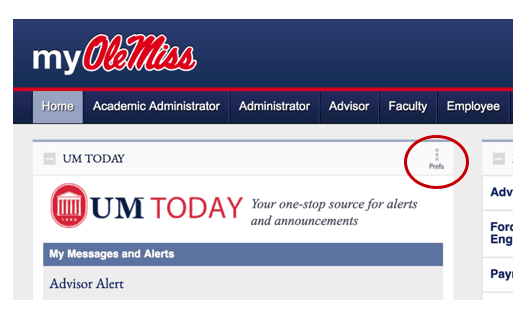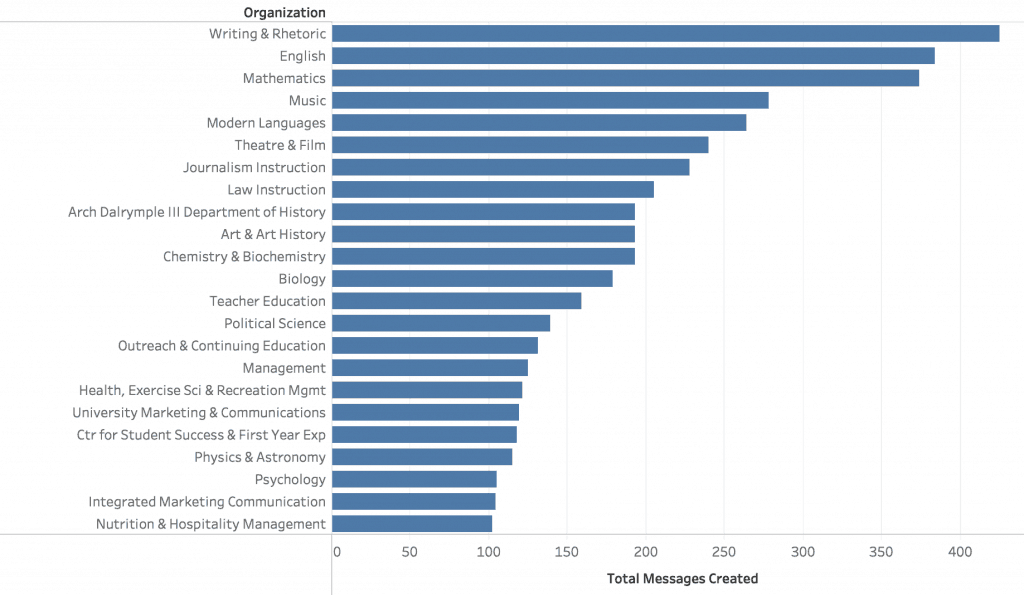Last November, the Office of Information Technology (IT) and University Communications requested feedback from the campus community on UM Today, a software framework for collecting, organizing and sharing announcements primarily among University of Mississippi (UM) students, faculty, and staff. We were pleased with both the number of responses (almost 900) and the quality of insights that came from this effort. This article summarizes the major themes from the survey and lists the steps that IT has taken to make improvements to UM Today based on these themes.
Background
UM Today has been in use since 2010 with a major “renovation” in early 2018. Before UM Today, the UM campus used an application called “Email to Groups” (ETG) whereby authorized employees would send bulk emails to flexible groupings of students, faculty, and staff. Believe it or not, UM began using ETG in 2005, almost 15 years ago! ETG was a good start, but it had some limitations, first of which was the amount of “internal spam” that it generated. We would receive email messages from various offices all day long, resulting in constant interruptions. Second, because email was sent via email, use of ETG was limited to “public” content. Communication with individual students about their grades, financial aid, or schedules was off limits due to the fact that email is not a secure means for exchanging information. Third, messages were not available for viewing beyond the email that was sent.
From ETG, we transitioned to UM Today with the parallel goals of an orderly, peaceful work environment with minimal interruptions AND easy, secure sharing of information between offices, faculty, advisors and the people they serve. From the start, the highest priority has been placed on communications between faculty/advisors/deans offices and students, i.e., messages that contribute toward learning and degree completion. This can be seen in Figure 1 showing the number of UM Today messages created by organization since January 2018. Note that the top fourteen are academic departments.
A common myth is, “No one reads UM Today.” When looking at the data, we find that many people are reading UM Today. If you define hit rate to be the ratio of # of people who read a message vs. the # of people in the targeted population, the highest hits rates occur among faculty to student and advisor to student communications, which is very good. The lowest hits rates occur for “blast” messages, e.g., those that go to all students, faculty, and staff. Generally, the lower the number of people targeted, the higher the hit rate. Beyond class news, advising-related messages, and personal alerts, the message types that have the highest hits rates are “Crime Alert,” “Payroll,” and “Provost” in that order.
We hear from both sides … those sending messages that they are not effectively reaching their constituencies and those receiving messages that they are being bombarded with too much information. This reflects the tension between information providers and information receivers. Those sending messages and creating events (naturally) hope that recipients will be as interested in the content as they are. In reality, some topics are applicable to only a small portion of the campus population. We must respect and balance the needs of both senders and receivers.
Survey Says …
As noted, almost 900 people responded to the survey. By and large, the tone of the responses was positive. We are grateful for the people who took the time to respond and the quality of comments they provided. The majors themes that emerged from the comments, together with the steps IT has taken to address them, are summarized next.
1. Too much information does not apply to me.
Among the comments in this category were:
- “I don’t know. I used to read it when I first started working here, but most of the information isn’t relevant to me, and I’m busy doing my job.”
- “You want to communicate, but you also surely don’t want to waste people’s time (and eventually, people won’t allot time to tasks perceived as unhelpful anyway).”
- “Make it short and sweet”
We need for senders of messages to hear this “loud and clear.” Sometimes, we observe that senders take the easiest route and send messages to everyone rather than targeting the people who are most likely to benefit from the message. Within UM Today, senders can select and filter to target almost any segment of UM’s population they wish. We need for senders to take the time to understand and use these features. Likewise, UM Today Express, a way to send an immediate email, needs to be used for time-urgent messages only. UM Today Express does not reflect the importance of a message, rather it exists for when waiting until the daily summary is posted is not practical. This leads to the next theme …
2. Recipients should have the ability to manage their preferences.
Actually, this feature already exists, but we have not actively promoted it. From the footer in the daily UM Today summary and from the myOleMiss “Home” tab (see Figure 2), you can select preferences to personalize your daily UM Today summary.

Figure 2. Link to Manage UM Today Preferences
Once there, you can manage whether you receive a daily summary or not as well as whether your summary contains headlines only or headlines and a brief description. Likewise, you can manage whether your daily summary contains new announcements only or all active announcements and events for today and tomorrow or events for the next week. Finally, you can set your own priorities for most message types, including whether to omit message types completely.

Figure 3. UM Today Preferences Screen Shot
IT has added a new feature that shows senders of messages how many people have opted out of their message types. This information appears when they are posting messages. We hope this will raise awareness about the need to be sensitive in not bombarding people with content or people will opt out of that content.
3. The daily UM Today summary contains too much redundant content from day to day.
Almost everyone is in agreement on this point. When senders post messages, they specify the start and end validity dates for messages. The default has been to show all messages that are currently active, with new items listed at the top. Based on the survey feedback, IT is changing the default for the daily email summary to be new items only. If you prefer to see all active items, you can manage your preferences accordingly (see #2). Please remember that all active announcements are shown in myOleMiss even if you choose only the new ones are included in the daily email summary. One final point is that announcements with priority 1 (emergency) and priority 2 (class news, advising, and personal alerts) are exempt from this processing, i.e., they will always appear regardless of whether they are new or not. Priority 2 announcements include the important categories of faculty to student and advisor to student communications, and we want to make sure students pay attention to these.
4. The daily UM Today summary should be posted during working hours.
A typical mailing of the UM Today summary results in almost 25,000 messages being posted. Moreover, each message is customized per recipient. IT aims to have these messages delivered to mailboxes before the work day starts, which can be quite early for some UM employees. IT has optimized this process so that the program runs in under 10 minutes, allowing the start time to be moved a little later. Even so, we believe that the larger issue may be that some people could benefit from instructions on how to manage “do not disturb” settings on their mobile devices. IT Helpdesk student Johnathan Taylor has provided help via a TechNews article titled, “Silence Notifications With Do Not Disturb.”
5. I should not have to login to read UM Today messages.
Your colleagues in IT might disagree on this point, but we are willing to compromise. Messages that deal with sensitive content do require authentication. There is a reason that you view messages from your health insurance provider, doctor’s office, and bank through a secure web interface rather than via email. Email is not secure. Likewise, we cannot endorse communicating sensitive information, e.g., academic guidance or financial aid details, via email. Remember that having a secure means for sharing sensitive information with students was a primary goal of UM Today. We certainly don’t want for anyone on the Internet to be able to freely peruse messages from instructors and advisors to students.
However, as some suggested, more general messages that go to thousands of people do not fall into this category and perhaps should be open. To help with this dilemma, IT has provided senders a way to bypass authentication for certain message types such as Campus News and Invitation. Senders will be responsible for determining whether it is appropriate to bypass authentication. Also, this choice will result in less detailed reporting, e.g., how many students/faculty/staff viewed the message.
6. UM Today summaries should have a more visually appealing layout.
Again, we agree with you on this point. Included among the challenges are to maintain a format that:
- Can be automated
- Is accessible to people with physical challenges
- Works well on a variety of mobile devices
Nevertheless, we understand the desire for increased visual appeal and are continuing to explore options.
Summary
The changes described here, with the exception of visual appeal, were implemented on or prior to March 18, 2019. Thank you again to those who responded to the survey, as well as to those who communicate directly with IT, for helping make UM Today a more effective communication tool. The timely, vibrant content distributed by so many using UM Today is inspiring and reflects the exciting and unique community of Ole Miss.
